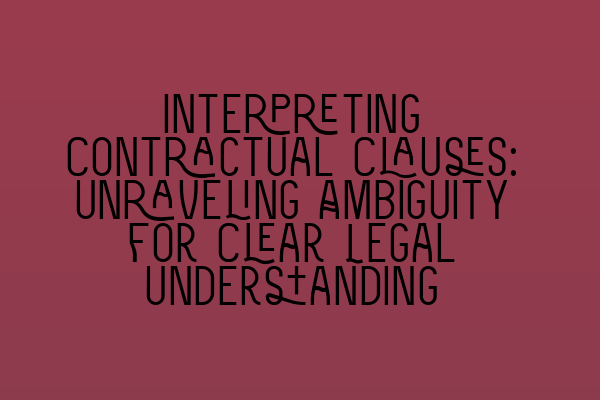Interpreting Contractual Clauses: Unraveling Ambiguity for Clear Legal Understanding
Welcome to our blog post on the complex yet fascinating topic of interpreting contractual clauses. As solicitors, it is our duty to carefully dissect and analyze the language used in contracts to ensure that our clients’ interests are protected. A crucial aspect of this process is deciphering any ambiguities that may arise, as they can have significant implications for the rights and obligations of the parties involved.
Before we delve into the intricacies of interpreting contractual clauses, let’s address a few commonly asked questions:
What is a Contractual Clause?
A contractual clause is a specific provision or term included in a contract that outlines the rights and obligations of the parties involved. These clauses serve as the building blocks of a contract, defining the scope and purpose of the agreement.
Why is Interpreting Contractual Clauses Important?
Interpreting contractual clauses is crucial in ensuring that both parties have a clear understanding of their obligations and rights under the contract. Ambiguities in these clauses can lead to misunderstandings, disputes, and even legal battles. Therefore, it is essential to interpret the language used in contracts accurately and objectively.
Common Challenges in Interpreting Contractual Clauses
When it comes to interpreting contractual clauses, several challenges can hinder clear understanding. One of the most prevalent challenges is ambiguity.
Unraveling Ambiguity
Ambiguity arises when the language used in a contractual clause can reasonably be understood in more than one way. It can stem from unclear or poorly drafted contract language or the context in which the clause is used. Ambiguities can create confusion and lead to differing interpretations by the parties involved.
For instance, consider a clause that states:
“Company A agrees to deliver the goods within a reasonable time.”
One interpretation could be that Company A has an obligation to deliver the goods within a specific time period, while another interpretation could be that Company A has the discretion to determine what constitutes a reasonable time. The lack of clarity in this clause opens the door to potential disputes.
So how do we unravel the ambiguity?
Applying The “Three-Legged Stool” Approach
In order to interpret contractual clauses accurately, solicitors often rely on the “Three-Legged Stool” approach, which consists of the following:
1. Literal Interpretation
The first leg of the stool involves a literal interpretation of the language used in the clause. Solicitors closely examine the words and phrases used, giving them their plain and ordinary meaning. This initial analysis helps establish the baseline understanding of the clause.
2. Contextual Interpretation
The second leg involves analyzing the broader context of the contract. Solicitors examine other provisions within the agreement to gain insight into the intentions of the parties. This can include reviewing definitions, section headings, and related articles or clauses. By considering the contract as a whole, solicitors can gain a clearer understanding of how the disputed clause should be interpreted.
For more information on interpreting contractual clauses within the context of SQE Contract Law, you may find it useful to explore our related article on SQE 2 Preparation Courses.
3. Purpose of the Contract
The third leg of the stool involves assessing the overarching purpose of the contract and the intentions of the parties involved. By understanding the underlying goals and objectives of the agreement, solicitors can determine how the disputed clause aligns with the overall intent of the contract.
As solicitors, we must balance these three legs of the stool to unravel the ambiguity and arrive at a fair and reasonable interpretation of the contractual clause.
Seeking Legal Assistance
Interpreting contractual clauses can be a complex and nuanced process. If you find yourself facing ambiguity in a contract, it is advisable to seek legal assistance to ensure that you protect your rights and interests. Consulting with a solicitor who specializes in contract law can provide you with the guidance and expertise necessary to navigate the interpretation process successfully.
If you are preparing for the SQE 1 Exam, you may find it helpful to check out our related article on SQE 1 Practice Exam Questions to further enhance your knowledge and understanding of contract law.
Additionally, if you are interested in our SQE exam preparation courses, we offer comprehensive resources and expert guidance. Explore our SQE 1 Preparation Courses and SQE 2 Preparation Courses to give yourself the best chance of success in the upcoming SRA SQE Exams. You can also find the latest exam dates on our SRA SQE Exam Dates page.
In conclusion, interpreting contractual clauses requires a comprehensive and balanced approach. By carefully unraveling ambiguity and applying the “Three-Legged Stool” approach, solicitors can arrive at a clear and fair interpretation of contractual clauses, protecting the rights and interests of their clients. Remember, when in doubt, seek legal advice!
